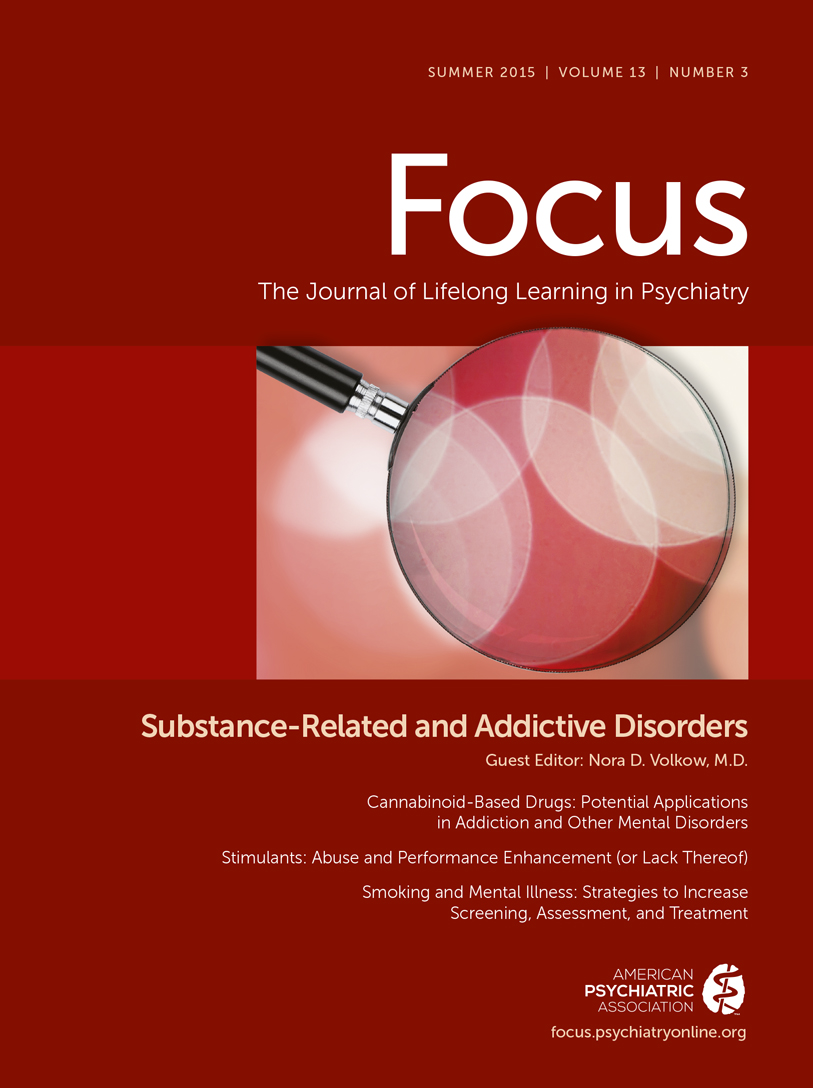Improvement in Medical Practice: Performance in Practice: Improvement in Medical Practice: Clinical Modules for Screening and for the Assessment and Treatment of Adults With Substance Use Disorders
The American Psychiatric Association’s (APA) Improvement in Medical Practice/Performance in Practice (PIP) clinical modules are designed to meet the requirements of the American Board of Medical Specialties (ABMS) and American Board of Psychiatry and Neurology (ABPN) Part IV of Maintenance of Certification (MOC). Part IV of MOC, Improvement in Medical Practice PIP clinical modules, is intended to assist in physicians’ evaluation of the quality of care provided in their practice, compared with peers and national benchmarks, and to facilitate practice improvements through the incorporation of best evidence or consensus recommendations to improve patient care. Physicians are required to complete one PIP unit every 3 years. There are two components for each PIP unit: the Clinical Module, consisting of chart reviews of at least five patients in a specific category, and the Feedback Module, which can include feedback from patients, peers, residents, or other members of the health care team. Psychiatrists in the 2013-2015 Continuous-MOC block must complete a Feedback Module. However, beginning in 2016, the Feedback Module will be OPTIONAL. Although the chart review shown in Appendices 1 and 2 is designed as a Clinical Module to facilitate physician practice assessment, this form also could be used in the Feedback Module for peer-review initiatives. Patient feedback is beyond the scope of this module.
There are three stages involved in each PIP unit [ABMS/ABPN—(1)]:
| • | Stage A, the baseline retrospective chart review of at least 5 patients in a specified category, which is then compared with “published best practices, practice guidelines, or peer-based standards”; | ||||
| • | Stage B, the design and implementation of a clinical practice improvement plan; and | ||||
| • | Stage C, subsequent remeasurement via a second chart review of 5 patients within the same category within 2 years after the initial chart review. Although the MOC program requires the review of at least five patient charts as part of each PIP unit, it is important to note that larger samples, i.e., reviews of more than 5 charts, will provide more accurate estimates of quality within a practice. | ||||
The Improvement in Medical Practice PIP clinical modules translate conceptual information from practice guidelines into practical steps, facilitating integration of evidence-based best practices into clinical care. The two PIP clinical modules presented here are designed to be relevant across clinical settings (e.g., inpatient, outpatient), straightforward and easy to complete, and usable in a pen-and-paper format to aid adoption. Furthermore, the practice guideline endorsed assessment and treatment recommendations highlighted in this clinical module have been rated at moderate-to-substantial levels of clinical confidence (3, 9), and evidence-rating levels of A and B (5, 6).
The questions included in the PIP clinical module for screening (Appendix 1) relate to initial screening of psychiatric patients to assess presence of SUD. The measures included in the PIP clinical module for assessment and treatment (Appendix 2) relate to subsequent care of patients with an existing diagnosis of SUD. In general, treatment options of diagnosed patients should follow the first-line evidence-based treatment recommendations. However, occasionally there may be appropriate clinical reasons for deviating from recommended care, including patient preferences, co-occurring psychiatric or medical conditions, and therapeutic benefits or side effects of prior treatments.
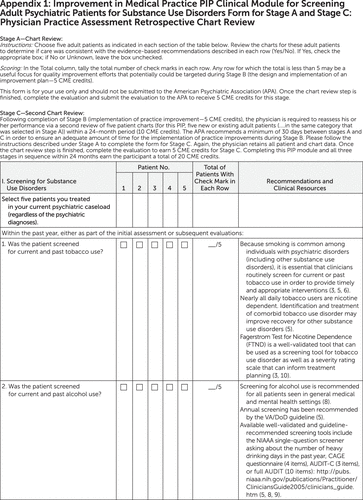
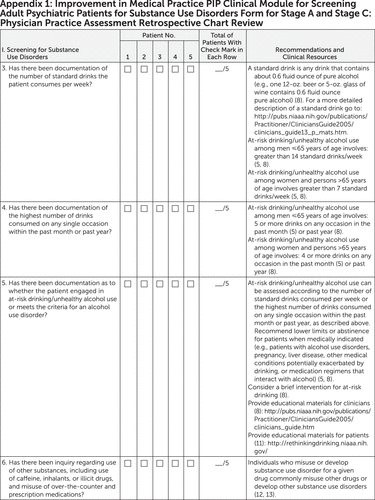



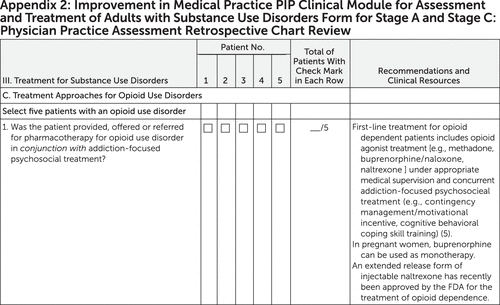
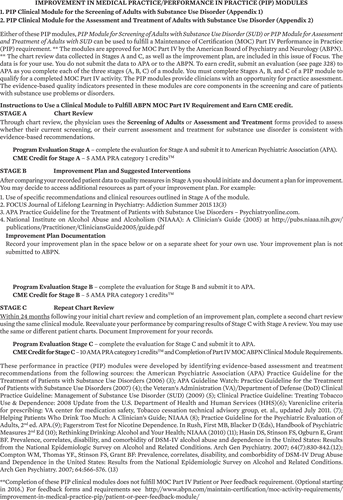

1 : 2013 http://www.abms.org/Maintenance_of_Certification/MOC_competencies.aspx http://www.abpn.com/downloads/moc/MOC_web_doc.pdfGoogle Scholar
2 : Diagnostic and Statistical Manual of Mental Disorders, 5th ed. Washington, DC, American Psychiatric Association, 2013Crossref, Google Scholar
3 Work Group on Substance Use Disorders. Kleber HD, Weiss RD, Anton RF, et al: Practice Guideline for the Treatment of Patients With Substance Use Disorders, second edition. American Psychiatric Association. Am J Psychiatry. 2007 April; Vol. 164, Suppl. 4: 5–123. http://psychiatryonline.org/pb/assets/raw/sitewide/practice_guidelines/guidelines/substanceuse.pdfGoogle Scholar
4 Connery HS, Kleber HD: Guideline Watch (April 2007): Practice Guideline for the Treatment of Patients With Substance Use Disorders, 2nd Edition. Focus Spring 2007 Vol. 5: 1–4 http://www.psychiatryonline.com/content.aspx?aid=149073Google Scholar
5 Management of SUD Working Group: VA/DoD Clinical Practice Guideline Management for Substance Use Disorders (SUD) 2009. Department of Veteran’s Affairs, Department of Defense, Washington, DC. http://www.healthquality.va.gov/Substance_Use_Disorder_SUD.aspGoogle Scholar
6 Clinical Practice Guideline: Treating Tobacco Use & Dependence: 2008 Update from the U.S. Department of Health and Human Services; http://www.surgeongeneral.gov/tobacco/treating_tobacco_use08.pdfGoogle Scholar
7 Varenicline criteria for prescribing: VA Center for Medication Safety, Tobacco Cessation Technical Advisory Group, et al., updated July 2011. http://www.healthquality.va.gov/Management_of_Tobacco_Use_MTU.aspGoogle Scholar
8 Helping Patients Who Drink Too Much: A Clinician’s Guide; U.S. Department of Health and Human Services, National Institutes of Health, National Institute on Alcohol Abuse and Alcoholism, NIH Publication 07–3769 www.niaaa.nih.gov/guide Rockville, Md. 2005 edition, reprinted May 2007 http://pubs.niaaa.nih.gov/publications/Practitioner/CliniciansGuide2005/clinicians_guide.htmGoogle Scholar
9 Work Group on Psychiatric Evaluation of Adults: Vergare MJ, Binder RL, Cook, IA, et al: Psychiatric Evaluation of Adults, second edition. American Psychiatric Association. 2006 Jun; 163(6 Suppl):3–36. http://www.psychiatryonline.com/pracGuide/pracGuideChapToc_1.aspxGoogle Scholar
10 : Fagerstrom Test for Nicotine Dependence, in Handbook of Psychiatric Measures, 2nd ed. Edited by Rush AJ, First MB, Blacker D. Rosslyn, VA, American Psychiatric Publishing Inc., 2008, pp 448–449Google Scholar
11 Drinking R: Alcohol and Your Health; U.S. Department of Health and Human Services, National Institutes of Health, National Institute on Alcohol Abuse and Alcoholism, NIH Publication 10-3770 Revised April 2010; http://rethinkingdrinking.niaaa.nih.gov/Google Scholar
12 : Prevalence, correlates, disability, and comorbidity of DSM-IV alcohol abuse and dependence in the United States: results from the National Epidemiologic Survey on Alcohol and Related Conditions. Arch Gen Psychiatry 2007; 64:830–842Crossref, Google Scholar
13 : Prevalence, correlates, disability, and comorbidity of DSM-IV drug abuse and dependence in the United States: results from the national epidemiologic survey on alcohol and related conditions. Arch Gen Psychiatry 2007; 64:566–576Crossref, Google Scholar


